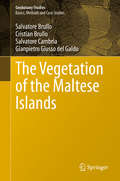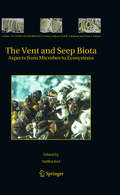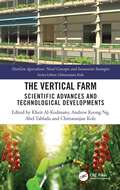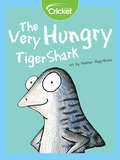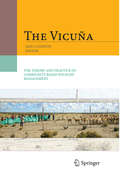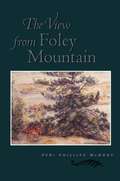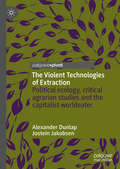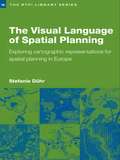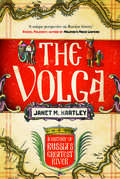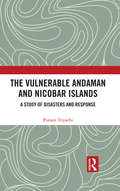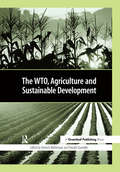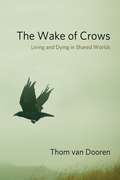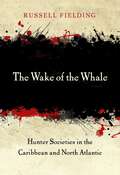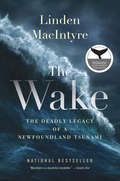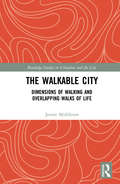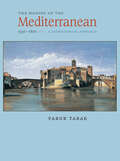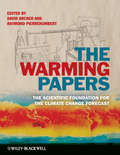- Table View
- List View
The Vegetation of the Maltese Islands (Geobotany Studies)
by Salvatore Brullo Cristian Brullo Salvatore Cambria Gianpietro Giusso del GaldoThis book discusses the remarkable plant diversity of the Maltese Archipelago. Despite its relatively small area and long-term human exploitation, many different plant communities occur in this territory. The book presents phytosociological investigations, together with taxonomical studies, which have been conducted over more than forty years, highlighting the unique features of this central Mediterranean insular ecosystem. It also describes the phytosociological role played by several narrow endemic or phytogeographically relevant taxa and introduces many phytocoenoses exclusively growing in the archipelago. The study integrates the palaeogeographic issues linked to the ancient and intriguing history of the different civilizations that succeeded on the islands for thousands of years. The book also focuses on the N2000 habitats.
The Vent and Seep Biota
by Steffen KielOases of life around black smokers and hydrocarbon seeps in the deep-sea were among the most surprising scientific discoveries of the past three decades. These ecosystems are dominated by animals having symbiotic relationships with chemoautotrophic bacteria. Their study developed into an international, interdisciplinary venture where scientists develop new technologies to work in some of the most extreme places on Earth. This book highlights discoveries, developments, and advances made during the past 10 years, including remarkable cases of host-symbiont coevolution, worms living on frozen methane, and a fossil record providing insights into the dynamic history of these ecosystems since the Paleozoic.
The Vertical Farm: Scientific Advances and Technological Developments (Nextgen Agriculture)
by Chittaranjan Kole Kheir Al-Kodmany Andrew Keong Ng Abel TabladaAmid economic uncertainties, fluctuating oil prices, and a rising environmental consciousness, the need for sustainable and efficient food production has become dire. The Vertical Farm: Scientific Advances and Technological Developments systematically navigates the realm of vertical farming (VF), rooted in a robust, scientific foundation. Unveiling the intricate convergence of plant biology, environmental science, and agronomy, it provides a profound understanding of contemporary agriculture. The book spans lighting systems and climate control mechanisms, focusing on sustainability. From small urban initiatives to significant commercial endeavors, real-world case studies showcase VF's adaptability, scalability, and resilience. Addressing multiple challenges, the book explores economic considerations and public perceptions, recognizing their roles in fostering meaningful advancements in agricultural innovation.A volume in the Nextgen Agriculture series, this book is valuable to scientists, practitioners, and students in urban agriculture and planning, horticulture, engineering, landscape architecture, and plant/technology sciences.
The Very Hungry Tiger Shark
by Liz HuyckTiger sharks eat almost anything they can catch. But the practice of dumping garbage in oceans is harmful to these predators who tend to eat something without realizing it isn’t food. This causes tiger sharks to eat license plates and other non-food items they cannot digest.
The Vicuña
by Kristi Anne Stølen Mariela Borgnia Verónica Benítez Jane C. Wheeler Hugo Yacobaccio Jerry Laker Renaudeau d' Arc Nadine Desmond Mcneill Cristian Bonacic Marcelo Cassini Gabriela Lichtenstein Yanina Arzamendia Pete Goddard Bibiana Vilá Jessica Gimpel Ana Wawrzyk Javier García Gomez Iain GordonThe vicuña is one of the few success stories of wildlife conservation. The focus is now shifting from protection to sustainable use. Internationally, policy development has followed the community-based conservation paradigm, which holds that economic benefits from wildlife management practices bring greater commitment on the part of local communities to protect both the species and its habitat. This book takes the position that sustainability is not guaranteed by sustainable use, and that both education and regulation are required to prevent the proliferation of unsustainable practices. The research from the countries presented in this book demonstrate the animal welfare, ecological, economic, social, and conservation trade-offs, which exist between different management systems. This links economics, social and conservation research to provide a unique insight into the viability of community-based wildlife management of a species which until recently was viewed simply as a conservation priority.
The View From Foley Mountain
by Peri Phillips McquayMy feet are practising their steps, gauging the slipperiness of wet lichen on rock and sounding each landing. As my stride shifts to a swing I realize I have a sharper sense of my place in the woods now. I am as taut and limber as a bow-string. I sense bears in the woods, weigh their threat and move on, glorying in the mosses beneath my feet …. We in the woods share fear. By grace of my fear, I am closer to predators and prey. The View From Foley Mountain is a celebration of the joy of living in harmony with the natural world. The seasonal selections lead you through the fields, woods, rock outcroppings and shores of the conservation area which is the author’s home. You will savour the fragrance of maple syrup boiling, share in a summer heron census, snowshoe to a beaver lodge, watch a snapping turtle laying eggs, witness the death of a starving deer, and see turkey vultures soar. Whether she is rejoicing in old barns, canoeing the Snake River, harvesting dye plants or stalking moths at night, Peri Phillips McQuay’s deep love and lyrical vision stimulate you to share her sense of wonder in her surroundings.
The Violent Technologies of Extraction: Political ecology, critical agrarian studies and the capitalist worldeater
by Alexander Dunlap Jostein JakobsenOffering a thought provoking theoretical conversation around ecological crisis and natural resource extraction, this book suggests that we are on a trajectory geared towards total extractivism guided by the mythological Worldeater. The authors discuss why and how we have come to live in this catastrophic predicament, rooting the present in an original perspective that animates the forces of global techno-capitalist development. They argue that the Worldeater helps us make sense of the insatiable forces that transform, convert and consume the world. The book combines this unique approach with detailed academic review of critical agrarian studies and political ecology, the militarization of nature and the conventional and ‘green’ extraction nexus. It seeks radical reflection on the role people play in the construction and perpetuation of these crises, and concludes with some suggestions on how to tackle them.
The Visual Language of Spatial Planning: Exploring Cartographic Representations for Spatial Planning in Europe (RTPI Library Series)
by Stefanie DührAt a time when strategic spatial planning is undergoing a renaissance in Europe, The Visual Language of Spatial Planning makes a unique contribution to this rapidly growing area of teaching and research. Discussing the relevant theoretical perspectives on policy-making and planning, combined with cartographic communication and the use of cartographic representations in the planning process, Stephanie Duhr provides conceptual and practical tools to help students and practitioners better understand maps and visualizations in strategic spatial planning. The book is the first to review the form, style and use of cartographic representations in strategic spacial plans in the Netherlands, Germany and England as well as at European level. Significant differences between planning traditions and the impact of these on transnational planning processes are highlighted. It concludes by discussing the practical implications for future strategic spacial planning processes in Europe and the best use of cartographic representations to reach agreement and to focus dialogue.
The Volcano Disaster
by Peg KehretWarren and Betsy have to work on a class project. Instead Warren is busy testing his grandfather's latest creation, the Instant Commuter. Suddenly, he is teleported back to the dawn of the eruption and he has no way of getting back home!
The Volga: A History
by Janet M. HartleyThe longest river in Europe, the Volga stretches over three and a half thousand km from the heart of Russia to the Caspian Sea, separating west from east. The river has played a crucial role in the history of the peoples who are now a part of the Russian Federation—and has united and divided the land through which it flows. Janet Hartley explores the history of Russia through the Volga from the seventh century to the present day. She looks at it as an artery for trade and as a testing ground for the Russian Empire’s control of the borderlands, at how it featured in Russian literature and art, and how it was crucial for the outcome of the Second World War at Stalingrad. This vibrant account unearths what life on the river was really like, telling the story of its diverse people and its vital place in Russian history.
The Voluntary Environmentalists
by Aseem Prakash Matthew PotoskiA novel theoretical framework to analyse the effectiveness of voluntary environmental programs, including ISO 14001.
The Voyage of Sorcerer II: The Expedition That Unlocked the Secrets of the Ocean’s Microbiome
by David Ewing Duncan J. Craig Venter“Will undoubtedly shape our understanding of the global ecosystem for decades to come.”—Siddhartha Mukherjee, author of The Emperor of All MaladiesA celebrated genome scientist sails around the world, collecting tens of millions of marine microbes and revolutionizing our understanding of the microbiome that sustains us.Upon completing his historic work on the Human Genome Project, J. Craig Venter declared that he would sequence the genetic code of all life on earth. Thus began a fifteen-year quest to collect DNA from the world’s oldest and most abundant form of life: microbes. Boarding the Sorcerer II, a 100-foot sailboat turned research vessel, Venter traveled over 65,000 miles around the globe to sample ocean water and the microscopic life within.In The Voyage of Sorcerer II, Venter and science writer David Ewing Duncan tell the remarkable story of these expeditions and of the momentous discoveries that ensued—of plant-like bacteria that get their energy from the sun, proteins that metabolize vast amounts of hydrogen, and microbes whose genes shield them from ultraviolet light. The result was a massive library of millions of unknown genes, thousands of unseen protein families, and new lineages of bacteria that revealed the unimaginable complexity of life on earth. Yet despite this exquisite diversity, Venter encountered sobering reminders of how human activity is disturbing the delicate microbial ecosystem that nurtures life on earth. In the face of unprecedented climate change, Venter and Duncan show how we can harness the microbial genome to develop alternative sources of energy, food, and medicine that might ultimately avert our destruction.A captivating story of exploration and discovery, The Voyage of Sorcerer II restores microbes to their rightful place as crucial partners in our evolutionary past and guides to our future.
The Voyageur Canadian Biographies 5-Book Bundle: The Firebrand / Mrs. Simcoe's Diary / The Scalpel, the Sword / The Men of the Last Frontier / Pilgrims of the Wild
by Julie Allan Grey Owl Michael Gnarowski James Polk William Kilbourn Ronald Stagg Mary Quayle Innis Elizabeth Posthuma Simcoe Hugh Eayrs Norman Bethune Allan Susan Ostrovsky Sydney GordonVoyageur Classics is a series of special versions of Canadian classics, with added material and new introductory notes. In this bundle we find five biographical and autobiographical titles that shed light on some of Canada’s most important figures at crucial times in the country’s development. William Kilbourn brings to life the rebel Canadian hero William Lyon Mackenzie: able political editor, first mayor of Toronto, and the gadfly of the House of Assembly. The Scalpel, the Sword celebrates the turbulent career of Dr. Norman Bethune, a brilliant surgeon, campaigner for socialized medicine, and communist. Elizabeth Simcoe’s diary, describing Canada from 1791 to 1796, is history written as it was being made, an account instilled with excitement and delight. And finally, two titles by the legendary Grey Owl tell his own astonishing story and advocate for a closeness with and respect for nature. Each of these books is an essential classic of Canadian literature. Includes The Firebrand Mrs. Simcoe’s Diary The Scalpel, the Sword The Men of the Last Frontier Pilgrims of the Wild
The Voyageur Canadian History 2-Book Bundle: The Refugee / The Letters and Journals of Simon Fraser, 1806-1808
by Benjamin Drew W. Kaye Lamb George E. ClarkeVoyageur Classics is a series that issues special new versions of Canadian classics, with added material and special introductions. In this bundle we find two classic works of Canadian historical writing. During three extraordinary years, 1805-1808, Simon Fraser undertook the third major expedition across North America, culminating in his famous journey down the river in British Columbia that now bears his name. Fraser’s exploratory efforts helped lead to Canada’s boundary later being declared at the 49th parallel. In this new volume, librarian and archivist W. Kaye Lamb provides a detailed introduction as well as illuminating annotations to Fraser’s journals. In the early 1850s, white American abolitionist Benjamin Drew was commissioned to travel to Canada West (now Ontario) to interview escaped slaves from the United States. In the course of his journeys in Canada, Drew visited Chatham, Toronto, Galt, Hamilton, London, Dresden, Windsor, and a number of other communities. Originally published in 1856, Drew’s book is the only collection of first-hand interviews of fugitive slaves in Canada ever done. It is an invaluable record of early black Canadian experience. Includes The Refugee The Letters and Journals of Simon Fraser, 1806-1808
The Vulnerable Andaman and Nicobar Islands: A Study of Disasters and Response
by Poonam TripathiThis first full-length book addresses disasters in the context of vulnerability of the Andaman and Nicobar Islands that comprise 572 islands in the Bay of Bengal. It looks at the disasters that the islands have experienced in the last 200 years and analyzes major disasters since colonization by the British. Raising some critical questions, this book attempts to understand the overall profile of disasters – the facts, causes, damage, response and recovery – in the Andaman and Nicobar Islands. It discusses earthquakes, cyclones, tsunami and epidemics, as well as impacts of World War II, the penal colony and the post-Independence resettlement on the tribal population. The work will serve as a rich resource with its detailed tables, figures, maps and diagrams; appendices; and database ranging from travelogues, Census of India reports and fieldwork to Right to Information (RTI) petitions that collect hitherto unknown facts. The book will be useful to students of geography, disasters and disasters management, climate and environmental studies, history, sociology, island and ocean studies, and South Asian studies.
The WTO, Agriculture and Sustainable Development
by Heinrich Wohlmeyer Theodor QuendlerDespite the Doha declaration of November 2001, the failure to start a new round of global trade negotiations at Seattle in December 1999 and the hostility of protesters to the trade liberalization process and growing global economic and social disparities was a wake-up call for the World Trade Organisation (WTO). The ambitious goal of this ground-breaking book is to identify the strengths and weaknesses of liberalized world trade, in particular in the agricultural sector, and to investigate to what extent the current WTO agreements provide the necessary fail-safe devices to react to trade-related negative impacts on sustainability, environmental protection and food security. The background and interrelationship between the WTO, the tenets of sustainable development and the unique features of the agriculture and forestry sectors are explored, and conclusions regarding the deficits of the world trade system and its conflicts with basic societal goals – such as sustainability – are drawn. Agriculture and forestry have a particular affinity with what the authors call "strong sustainability" and are to be among the major agenda items in forthcoming WTO negotiations. The book proposes that sustainable agricultural production techniques such as integrated and organic farming provide a series of related services to community and environment which could be severely prejudiced by wholesale trade liberalization and the imposition of the large-scale production methods of the mega-trade giants of the USA and Europe. And yet the concept of sustainability is referred to only tangentially in the existing WTO agenda. The WTO, Agriculture and Sustainable Development argues that, without a formal recognition of this failing, the premise that free trade is inherently advantageous for all countries is a falsehood. Further, unfettered liberalization is unsustainable and a social and environmental multilateral framework must be agreed to reinterpret or adapt a host of WTO regulations that are at odds with sustainable development. The core problem is that, under the current system, import duties can only be differentiated by direct goods and services and not by their means of production – sustainable or otherwise. Therefore, a range of environmental policy measures in the agricultural sector, such as the consideration of product life-cycles, the internalization of external costs and a coupling of trade liberalization with ecological obligations are proposed by the authors. In addition, they argue that unsustainable economic short-termism must be curbed and the use of the stick of trade sanctions and the carrot of financial benefits for good environmental performance be permitted to promote sustainable agricultural practices. This book will contribute greatly in addressing the lack of basic theoretical arguments at the intersection between trade and sustainable development – a failing that has already been bemoaned by trade policy-makers. It is highly recommended reading for all those involved or interested in the WTO negotiations, whether from multilateral organizations, governments, industry or civil society.
The Wake of Crows: Living and Dying in Shared Worlds (Critical Perspectives on Animals: Theory, Culture, Science, and Law)
by Thom van DoorenCrows can be found almost everywhere that people are, from tropical islands to deserts and arctic forests, from densely populated cities to suburbs and farms. Across these diverse landscapes, many species of crow are doing well: their intelligent and adaptive ways of life have allowed them to thrive amid human-driven transformations. Indeed, crows are frequently disliked for their success, seen as pests, threats, and scavengers on the detritus of human life. But among the vast variety of crows, there are also critically endangered species that are barely hanging on to existence, some of them the subjects of passionate conservation efforts.The Wake of Crows is an exploration of the entangled lives of humans and crows. Focusing on five key sites, Thom van Dooren asks how we might live well with crows in a changing world. He explores contemporary possibilities for shared life emerging in the context of ongoing processes of globalization, colonization, urbanization, and climate change. Moving among these diverse contexts, this book tells stories of extermination and extinction alongside fragile efforts to better understand and make room for other species. Grounded in the careful work of paying attention to particular crows and their people, The Wake of Crows is an effort to imagine and put into practice a multispecies ethics. In so doing, van Dooren explores some of the possibilities that still exist for living and dying well on this damaged planet.
The Wake of HMS Challenger: How a Legendary Victorian Voyage Tells the Story of Our Oceans' Decline
by Gillen D’Arcy WoodA scientific adventure story that dramatizes how profoundly our oceans have changed over the past 150 yearsIn December 1872, HMS Challenger embarked on the first round-the-world oceanographic expedition. Its goal: to shine a light for the first time on the mysteries of the deep sea. For the next four years, Challenger&’s naturalists explored the oceans, encountering never-before-seen marvels of marine life. The expedition&’s achievements are the stuff of legend. It identified major ocean currents and defining features of the seafloor, including the Mid-Atlantic Ridge and Mariana Trench. It measured worldwide sea temperatures and chemistry, creating baseline data for all ocean research since. And, most spectacularly of all, it collected nearly five thousand sea creatures and plants new to science. In The Wake of HMS Challenger, Gillen D&’Arcy Wood looks afresh at this legendary scientific odyssey and shows why, 150 years later, its legacy looms larger than ever.The Challenger&’s scientists had no way of knowing that the incredible undersea aquarium they were documenting was on the verge of catastrophic change. Off Portugal, they encountered a brilliant starfish now threatened with extinction by microplastics; in St. Thomas, teeming coral habitats that today have been decimated by ocean warming; and at remote Ascension Island, the breeding grounds of the now-endangered green turtle. Lyrical and elegiac, The Wake of HMS Challenger offers a stunning before-and-after picture of our global oceans. It is both a reminder of what we have lost since the Victorian age and an urgent call to preserve what remains of the diverse life and wild beauty of our planet&’s final frontier.
The Wake of the Whale: Hunter Societies in the Caribbean and North Atlantic
by Russell FieldingDespite declining stocks and health risks, island communities in the Caribbean and North Atlantic still use traditional methods to hunt whales and dolphins for food. Russell Fielding presents the art, history, and purpose of whaling in these different cultures and describes what their future might look like as modern realities take hold.
The Wake: The Deadly Legacy of a Newfoundland Tsunami
by Linden MacIntyreIn the vein of Erik Larson’s Isaac’s Storm and Dead Wake comes an incredible true story of destruction and survival in Newfoundland by one of Canada’s best-known writersOn November 18, 1929, a tsunami struck Newfoundland’s Burin Peninsula. Giant waves, up to three storeys high, hit the coast at a hundred kilometres per hour, flooding dozens of communities and washing entire houses out to sea. The most destructive earthquake-related event in Newfoundland’s history, the disaster killed twenty-eight people and left hundreds more homeless or destitute. It took days for the outside world to find out about the death and damage caused by the tsunami, which forever changed the lives of the inhabitants of the fishing outports along the Burin Peninsula.Scotiabank Giller Prize–winning writer Linden MacIntyre was born near St. Lawrence, Newfoundland, one of the villages virtually destroyed by the tsunami. By the time of his birth, the cod-fishing industry lay in ruins and the village had become a mining town. MacIntyre’s father, lured from Cape Breton to Newfoundland by a steady salary, worked in St. Lawrence in an underground mine that was later found to be radioactive. Hundreds of miners would die; hundreds more would struggle through shortened lives profoundly compromised by lung diseases ranging from silicosis and bronchitis to cancer. As MacIntyre says, though the tsunami killed twenty-eight people in 1929, it would claim hundreds if not thousands more lives in the decades to follow. And by the time the village returned to its roots and set up as a cod fishery once again, the stocks in the Grand Banks had plummeted and St. Lawrence found itself once again on the brink of disaster.Written in MacIntyre’s trademark style, The Wake is a major new work by one of this country’s top writers.
The Walkable City: Dimensions of Walking and Overlapping Walks of Life (Routledge Studies in Urbanism and the City)
by Jennie MiddletonThis book explores everyday walking in contemporary urban life. It brings together important theoretical and empirical insights to understand how the ‘walkability’ of urban spaces can be imagined, planned for, and experienced. The book focuses on the everyday experiences of the urban walker, the bodily experiences of walking, and different walking research methods. It goes beyond the conventional focus on walkable places by delving into the ways in which urban space is consumed and produced through different ways of walking. Drawing on fieldwork in the UK and international secondary sources, the book examines how walking is socially and materially co-produced, focusing on pedestrian practices, infrastructures, and the social nature of walking. Chapters in the book offer key explorations of the cultural and social inclusions and exclusions of navigating the city on foot. The book considers transport planning and policy promoting pedestrian movement, pedestrian infrastructures, the politics of walking, and social interactions of urban pedestrians. The book offers vital analyses of how different but overlapping dimensions of walking and their relationship with urban space are often overlooked, and the importance of centring the lived experiences of walking in understandings of pedestrian practices. This book provides a timely contribution to the field of mobilities due to a growing interest in urban walking. It will be of interest to students and scholars of urban studies, human geography, sociology, and public health.
The Walkable City: Dimensions of Walking and Overlapping Walks of Life (Routledge Studies in Urbanism and the City)
by Jennie MiddletonThis book explores everyday walking in contemporary urban life. It brings together important theoretical and empirical insights to understand how the ‘walkability’ of urban spaces can be imagined, planned for, and experienced. The book focuses on the everyday experiences of the urban walker, the bodily experiences of walking, and different walking research methods. It goes beyond the conventional focus on walkable places by delving into the ways in which urban space is consumed and produced through different ways of walking. Drawing on fieldwork in the UK and international secondary sources, the book examines how walking is socially and materially co-produced, focusing on pedestrian practices, infrastructures, and the social nature of walking. Chapters in the book offer key explorations of the cultural and social inclusions and exclusions of navigating the city on foot. The book considers transport planning and policy promoting pedestrian movement, pedestrian infrastructures, the politics of walking, and social interactions of urban pedestrians. The book offers vital analyses of how different but overlapping dimensions of walking and their relationship with urban space are often overlooked, and the importance of centring the lived experiences of walking in understandings of pedestrian practices. This book provides a timely contribution to the field of mobilities due to a growing interest in urban walking. It will be of interest to students and scholars of urban studies, human geography, sociology, and public health.
The Waning of the Mediterranean, 1550–1870: A Geohistorical Approach
by Faruk Tabak2008 Outstanding Academic Title, Choice MagazineConventional scholarship on the Mediterranean portrays the Inner Sea as a timeless entity with unchanging ecological and agrarian features. But, Faruk Tabak argues, some of the "traditional" and "olden" characteristics that we attribute to it today are actually products of relatively recent developments. Locating the shifting fortunes of Mediterranean city-states and empires in patterns of long-term economic and ecological change, this study shows how the quintessential properties of the basin—the trinity of cereals, tree crops, and small livestock—were reestablished as the Mediterranean's importance in global commerce, agriculture, and politics waned.Tabak narrates this history not from the vantage point of colossal empires, but from that of the mercantile republics that played a pivotal role as empire-building city-states. His unique juxtaposition of analyses of world economic developments that flowed from the decline of these city-states and the ecological change associated with the Little Ice Age depicts large-scale, long-term social change. Integrating the story of the western and eastern Mediterranean—from Genoa and the Habsburg empire to Venice and the Ottoman and Byzantine empires—Tabak unveils the complex process of devolution and regeneration that brought about the eclipse of the Mediterranean.
The War Against the Greens: The "Wise-Use" Movement, the New Right, and Anti-Environmental Violence
by David HelvargA shadowy backlash against environmentalists has begun to emerge in America, the most visible element of which calls itself the "Wise Use" movement. Among its stated goals are the unregulated use of timber, oil, gas, minerals, and range land, and the abolition of all environmental laws and agencies.
The Warming Papers: The Scientific Foundation for the Climate Change Forecast
by David ArcherChosen for the 2011 ASLI Choice - Honorable Mention (History Category) for a compendium of the key scientific papers that undergird the global warming forecast. Global warming is arguably the defining scientific issue of modern times, but it is not widely appreciated that the foundations of our understanding were laid almost two centuries ago with the postulation of a greenhouse effect by Fourier in 1827. The sensitivity of climate to changes in atmospheric CO2 was first estimated about one century ago, and the rise in atmospheric CO2 concentration was discovered half a century ago. The fundamentals of the science underlying the forecast for human-induced climate change were being published and debated long before the issue rose to public prominence in the last few decades. The Warming Papers is a compendium of the classic scientific papers that constitute the foundation of the global warming forecast. The paper trail ranges from Fourier and Arrhenius in the 19th Century to Manabe and Hansen in modern times. Archer and Pierrehumbert provide introductions and commentary which places the papers in their context and provide students with tools to develop and extend their understanding of the subject. The book captures the excitement and the uncertainty that always exist at the cutting edge of research, and is invaluable reading for students of climate science, scientists, historians of science, and others interested in climate change.
